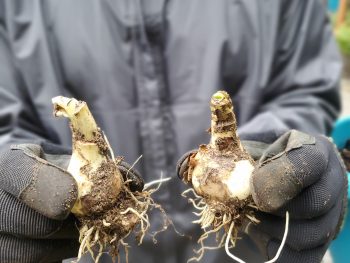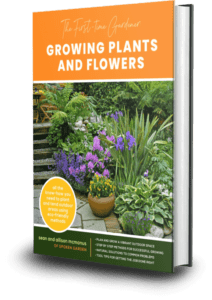Listen to learn the 3 steps to divide and separate your daffodil bulbs this fall on this quick DIY Garden Minute podcast.
Subscribe on iTunes Stitcher Spotify
Watch Us on YouTube

How to Divide Daffodil Bulbs
This fall, we are refreshing containers with new daffodil bulbs in anticipation for this coming spring.
As we refresh each containers soil, we are finding (surprise!) last year’s daffodil bulbs and they have multiplied. Wow!
As we make room in our containers for planting new bulbs, we need to separate and plant these older bulbs.
If you have older clumps of daffodil bulbs in your garden that need to be separated, here are our steps to divide them:
- Dig down to 5 or 6 inches down and 3 or more inches around where the daffodil bulbs are. If you need to explore around the soil, then just make sure to do it slowly.
- Once the group of bulbs are dug up, nicely remove any soil from them to really expose each bulb clump so you can see where they are connected. The bulbs will be slightly different sizes in each grouping so just be aware of that.
- Placing each thumb on a bulb opposite of each other, gently pull the bulbs away from each other and slowly separate the bulb roots so you cause the least amount of damage to each bulb.
That’s it! Continue these steps to keep separating bulbs from each other. You can now add these small bulbs to other areas of your garden or give away as gifts to other gardeners!
Note that the younger bulbs will take at least one more year of leaf growth and growing cycle for them to fully develop and have their first flower.
How to Know If Bulbs Are Healthy to Replant After Separating Them
You will need to visually inspect each bulb, either before or after you separate them, to know if they are healthy enough to be replanted out in your garden or in a container. It would be a shame to replant a bulb that you knew didn’t have a good chance re-emerging next spring, beacuse you want to be able to count on that beautiful flower coming up and be able to enjoy it, right?
Here are 3 signs to look for to know if you should replant any bulb or not:
- When you handle any bulb, take into account if it feels solid or has some weight to it. If it doesn’t feel solid or feels like it is really light, then there is a good chance it is already dead and you should discard it instead of replanting it.
- As you look at each bulb, look for any signs of slime or mucous on the the surface of the bulb. If yo use either slime or mucous, discard that bulb as it is rotting and could spread to other surrounding bulbs.
- Look for any bite marks or chunks that look like they have been bitten out of each bulb. If any bulb is damaged over the majority of it’s surface from biting or is missing a 1/3 of it’s mass due to what looks like biting, discard that bulb because the damage is too severe for it to survive over the fall and winter to then re-emerge the next spring.
Our YouTube Video on the Importance of Fall Mulching
Resources:
Some of the resources and products below may be affiliate links, meaning we might get paid a commission (at no extra cost to you) if you use that link to make a purchase.
3Tips to Properly Plant Perennials This Fall – DIY Ep. 212 (Podcast)
How to Take Coleus Cuttings– (YouTube Video)
Order our New Book: First-time Gardener: Growing Plants and Flowers. Available on Amazon!
You can find more specific seed sowing and growing information when you order our new book “The First-time Gardener: Growing Plants and Flowers” on Amazon, available now!
If you aren’t sure where to start learning about garden care, go to our Start Here page at spokengarden.com/start-here .
And, if you have questions about these or other plants, we are here to help, so please email us.
Thanks for Listening!!!
That’s all for this podcast episode! You can find other beginning gardener topics on our podcast page by clicking here or go to SpokenGarden.com and click on the “Listen” tab.
Also find us on your favorite podcast platform and smart speaker!
Share Your Thoughts:
- Leave a note in the comment section below.
- Leave comments/ suggestions at Seanandallison@eseospace.dev
- Share our show or follow us on YouTube, Instagram, Twitter, Facebook, or Pinterest.
To Help Us Out:
- Leave a review on iTunes. Your ratings and reviews really help us reach new listeners to help them in their gardens!
*Spoken Garden is a participant in the Amazon Services LLC Associates Program, an affiliate advertising program designed to provide a means for sites to earn advertising fees by advertising and linking to Amazon.com.



